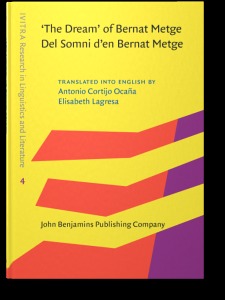

Paul Spalding-Mulcock, Features Writer
Exploring Catalan Literature - Part Two: The Past Defines The Present

It's true to say that Catalonia has endured a turbulent past, however its very character may be intuited through the words of Maya Angelou: “I can be changed by what happens to me. But I refuse to be reduced by it”. So with the above in mind, I asked Tiago Miller to provide me with some historical context as a way of understanding the formation and development of its literary voice, Catalan.
“Well, I think it’s important to mention right from the start that Catalan has a rich medieval artistic, political and literary tradition. One only has to stroll around the centre of Barcelona or Girona to see this reflected in the architecture.
Nevertheless, the cultural and literary hub for the Catalan language in the fifteenth century was, in fact, Valencia, to the point that we now talk about a Valencian Golden Age, with the most prominent writers being the poet Ausiàs March the doctor-poet Jaume Roig and the chivalric novelist Joanot Martorell. However, the founding works of this era are undoubtedly The Dream by humanist Bernat Metge and the extensive, multilingual oeuvre of Majorcan writer, philosopher, mystic and theologian Ramon Llull.”
Catalan has a rich medieval artistic, political and literary tradition... stroll around the centre of Barcelona or Girona to see this reflected in the architecture.
I had a groggy notion that Catalonia, as with so many other lands, had suffered a form of ‘Dark Age’. Suspecting that my grasp of the Decadència was at best superficial, and likely to be based upon erroneous assumptions, I asked Tiago to enlighten me.“The Decadència, as the name suggests, represents a decline in the political, economic and literary might of Catalonia. The Catholic Kings’, (Ferdinand and Isabelle) patronage of Christopher Columbus in 1492 serves as a before and after if ever there was one. Power shifted from the Mediterranean to the Atlantic – just look at Seville’s Baroque centre dripping with gold – and Catalonia’s influence diminished amid growing tensions.
But there are two conflicts that seal Catalonia’s modern fate: firstly, the Reaper’s War (1640-52), which ended in the Treaty of the Pyrenees and a considerable redrawing of the continent’s, (and Catalonia’s) borders, and secondly, the War of Spanish Succession between the Habsburgs and the Bourbons over the throne left vacant by the heirless Charles II of Spain.

Obviously, the idea that this is some sort of Dark Ages is not true, and many historians dispute the validity of the term ‘Decadència’, but there is certainly a conscious move to imitate Spanish literary forms and Catalan writers were heavily influenced by the works of Luis de Góngora, Francisco de Quevado and other poets and essayists associated with the Spanish Golden Age. After the fall of Catalonia in 1714, the absolutist monarchy sought to forcibly impose the Castilian language in Catalonia – or what they termed ‘the provinces’ – and many Catalan writers swapped their native language for Spanish to create their works of literature.”
So, we know that a community’s identity is inexorably entwined with its lexicon and the language it uses to voice its thoughts. Tiago described how Catalan became the idiosyncratic, or more accurately, the proudly chosen voice of Catalonia’s intellectual and creative community:
“It wouldn’t be until the nineteenth century when this reality would begin to change after the flowering of what has come to be known as the Catalan Renaissance (La Renaixença, 1833-1892), which had the objective of recuperating the Catalan language and defining Catalan national identity, while also adapting it to contemporary political and cultural currents. This paved the way for the emergence of two of the most important literary movements in the history of Catalonia: Modernism and Noucentisme.
...Voltaire refers to Catalonia as ‘one of the most fertile lands on earth yet one of the most unfortunately situated.’
Coinciding with a time of rapid industrialisation and greater integration into domestic and international markets, the intellectuals that formed these two movements sought to put Catalonia on the map. Basically, when they looked back they saw a wilderness, a country that had been reduced to the level of an unambitious province adrift of great European culture and artistic developments. Despite being diametrically opposite in style, both movements were responsible for translations of ancient and modern classics into the Catalan language and a flowering of style and genre. Writers included such canonical figures as Joan Maragall, Eugeni d’Ors, Prudenci Bertrana and Joaquim Ruyra, nevertheless, the crowning glories of this era are certainly the narrative fiction of Victor Català, the poetry of J.V. Foix, the prose of Josep Pla and the architecture of Antoni Gaudí.”

Montserrat Roig
“Out of this nascent Catalanism came new political organisations, including the Mancomunitat in 1914 and the reestablishment of the Generalitat in 1931, and new political leaders, such as Francesc Macià, who would famously declare Catalonia as a free state within an Iberian federation from the balcony of the Generalitat, and Lluís Companys, who would be executed by firing squad at Montjuïc Castle in the immediate aftermath of the Spanish Civil War.
Up until the war, Catalan culture brimmed with activity and potential, and was on course to develop in a free and far-reaching manner, but Nationalist victory and the resulting fascist dictatorship was – in the words of the award-winning writer Raül Garrigasait – ‘like sulphuric acid for Catalan language and culture.’
It’s estimated that more than half a million Republicans went into exile, meaning that some of the most important twentieth century Catalan literature was written abroad, for example in Switzerland (Mercè Rodoreda), Mexico (Pere Calders) and France (Carles Riba) and Belgium (Josep Carner). The immediate post-war years were brutal, consisting of executions, imprisonments and purges (so much so that some historians see the war as not ending until 1952), but as the regime embarked on a new economic programme in the 1960s some literature was indeed published in Catalan, subject to stringent censorship.
Up until the war, Catalan culture brimmed with activity and potential, and was on course to develop in a free and far-reaching manner...
Two of the most prominent writers who remained in Catalonia after the war were Maria Aurèlia Capmany and Manuel de Pedrolo, both of whom had numerous works censored by the regime. After the Transition, Capmany would enter into politics while Pedrolo would remain forever on the fringes. Nevertheless, the collection Cua de palla, headed by Pedrolo , sought to bring more popular genres into the Catalan language. Without linguistic and publishing freedom, Catalan had been left cut off – stranded even – at a point when it was concerned with creating a great literary tradition based on the values of ancient Greece and the European avant-garde, but without popular culture as its foundation, no language can exist.
Pedrolo, in his role as editor, and Capmany, in her capacity as translator (among other prominent Barcelona writers), were acutely aware of this, and they set about creating affordable paperback translations of crime and pulp writers such as John le Carré, Dashiell Hammet, Raymond Chandler and Georges Simenon.”
After the death of Franco and the resulting enervation of his grossly deleterious influence, I wanted to understand what happened next in Catalan’s turbulent tale. Tiago considered the question and responded…
“A new wave of young, university educated, politically engaged writers were beginning to publish their first works, most notably female writers such as Montserrat Roig, Maria-Mercè Marçal, Carme Riera and Maria Antònia Oliver. The combative nature of these writers is perhaps best summed up by Montserrat Roig when she says, ‘If anyone asks me why I write in Catalan, three reasons come to mind: firstly, because it’s my language; secondly, because it’s a literary language; and thirdly, I write in Catalan because I damn well feel like it’.
Maria-Mercè Marçal, who famously wrote, ‘I am grateful to fate for three gifts: to have been born a woman, from the working class, in an oppressed nation. And the turbid azure of being three times a rebel.’ In fact, Roig found out she’d won the 1970 Mercè Rodoreda Prize for short fiction while occupying the abbey at Montserrat with 250 other intellectuals in protest of the summary execution of 16 Basque militants."
…………………………………………………………………………………………
Having examined the roots of what would become the flowerings of contemporary Catalonian literature, the next article in this series will place its focus upon what characterises this fecund literary period in terms of its stylistic identity, thematic substance and the nature of its creators. We will also explore the factors helping to both colour and shape it from the 1970’s onwards.
More articles in this series...
Exploring Catalan Literature - Part Eight (Conclusion): To See The Wood For The TreesExploring Catalan Literature - Part Seven : All That Glitters Is Not GoldClassicism…Muse, Mistress And Mentor: Exploring Catalan Literature - Part Six…From The Beloved Soil, Precious Flowers Bloom : Exploring Catalan Literature - Part Five… Nothing Worth Discussing Is Ever Straightforward ! Exploring Catalan Literature - Part FourExploring Catalan Literature - Part Three: The 1970’s OnwardsExploring Catalonian Literature: Introducing A New Seven-Part Series